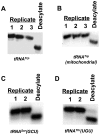Determination of tRNA aminoacylation levels by high-throughput sequencing
- PMID: 28586482
- PMCID: PMC5737633
- DOI: 10.1093/nar/gkx514
Determination of tRNA aminoacylation levels by high-throughput sequencing
Abstract
Transfer RNA (tRNA) decodes mRNA codons when aminoacylated (charged) with an amino acid at its 3' end. Charged tRNAs turn over rapidly in cells, and variations in charged tRNA fractions are known to be a useful parameter in cellular responses to stress. tRNA charging fractions can be measured for individual tRNA species using acid denaturing gels, or comparatively at the genome level using microarrays. These hybridization-based approaches cannot be used for high resolution analysis of mammalian tRNAs due to their large sequence diversity. Here we develop a high-throughput sequencing method that enables accurate determination of charged tRNA fractions at single-base resolution (Charged DM-tRNA-seq). Our method takes advantage of the recently developed DM-tRNA-seq method, but includes additional chemical steps that specifically remove the 3'A residue in uncharged tRNA. Charging fraction is obtained by counting the fraction of A-ending reads versus A+C-ending reads for each tRNA species in the same sequencing reaction. In HEK293T cells, most cytosolic tRNAs are charged at >80% levels, whereas tRNASer and tRNAThr are charged at lower levels. These low charging levels were validated using acid denaturing gels. Our method should be widely applicable for investigations of tRNA charging as a parameter in biological regulation.
© The Author(s) 2017. Published by Oxford University Press on behalf of Nucleic Acids Research.
Figures




Similar articles
-
A robust method for measuring aminoacylation through tRNA-Seq.Elife. 2024 Jul 30;12:RP91554. doi: 10.7554/eLife.91554. Elife. 2024. PMID: 39076160 Free PMC article.
-
The landscape of Arabidopsis tRNA aminoacylation.Plant J. 2024 Dec;120(6):2784-2802. doi: 10.1111/tpj.17146. Epub 2024 Nov 18. Plant J. 2024. PMID: 39555621 Free PMC article.
-
Detection and quantification of glycosylated queuosine modified tRNAs by acid denaturing and APB gels.RNA. 2020 Sep;26(9):1291-1298. doi: 10.1261/rna.075556.120. Epub 2020 May 21. RNA. 2020. PMID: 32439717 Free PMC article.
-
Transfer RNA: a dancer between charging and mis-charging for protein biosynthesis.Sci China Life Sci. 2013 Oct;56(10):921-32. doi: 10.1007/s11427-013-4542-9. Epub 2013 Aug 27. Sci China Life Sci. 2013. PMID: 23982864 Review.
-
The complement of cytoplasmic tRNAs, including queuosine-containing tRNAs, in adult and senescent Wistar rat liver and their levels of aminoacylation.Mech Ageing Dev. 1982 Dec;20(4):289-304. doi: 10.1016/0047-6374(82)90097-5. Mech Ageing Dev. 1982. PMID: 6820101 Review.
Cited by
-
i-tRAP (individual tRNA acylation PCR): A convenient method for selective quantification of tRNA charging.RNA. 2022 Oct 25;29(1):111-22. doi: 10.1261/rna.079323.122. Online ahead of print. RNA. 2022. PMID: 36283829 Free PMC article.
-
Multiple mechanisms activate GCN2 eIF2 kinase in response to diverse stress conditions.Nucleic Acids Res. 2024 Feb 28;52(4):1830-1846. doi: 10.1093/nar/gkae006. Nucleic Acids Res. 2024. PMID: 38281137 Free PMC article.
-
ALL-tRNAseq enables robust tRNA profiling in tissue samples.Genes Dev. 2023 Mar 1;37(5-6):243-257. doi: 10.1101/gad.350233.122. Epub 2023 Feb 21. Genes Dev. 2023. PMID: 36810209 Free PMC article.
-
Improved TGIRT-seq methods for comprehensive transcriptome profiling with decreased adapter dimer formation and bias correction.Sci Rep. 2019 May 28;9(1):7953. doi: 10.1038/s41598-019-44457-z. Sci Rep. 2019. PMID: 31138886 Free PMC article.
-
Cross-editing by a tRNA synthetase allows vertebrates to abundantly express mischargeable tRNA without causing mistranslation.Nucleic Acids Res. 2020 Jul 9;48(12):6445-6457. doi: 10.1093/nar/gkaa469. Nucleic Acids Res. 2020. PMID: 32484512 Free PMC article.
References
-
- Elf J., Nilsson D., Tenson T., Ehrenberg M.. Selective charging of tRNA isoacceptors explains patterns of codon usage. Science. 2003; 300:1718–1722. - PubMed
MeSH terms
Substances
Grants and funding
LinkOut - more resources
Full Text Sources
Other Literature Sources
Molecular Biology Databases

